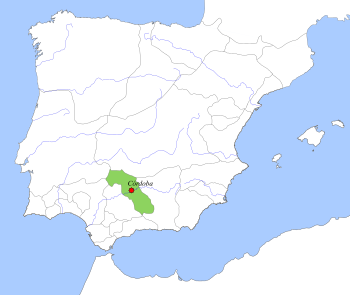Taifa of Córdoba facts for kids
Quick facts for kids
Taifa of Córdoba
طائفة قرطبة (Arabic)
|
|||||||||
|---|---|---|---|---|---|---|---|---|---|
| 1031–1091 | |||||||||

Taifa Republic of Córdoba, c. 1037.
|
|||||||||
| Capital | Córdoba | ||||||||
| Common languages | Mozarabic, Arabic, Hebrew | ||||||||
| Religion | Sunni Islam, Roman Catholicism, Judaism | ||||||||
| Government | Republican emirate | ||||||||
| Historical era | Middle Ages | ||||||||
|
• Córdoba organized into a republic
|
1031 | ||||||||
|
• Córdoban ruler imprisoned and exiled
|
1091 | ||||||||
| Currency | Dirham and Dinar | ||||||||
|
|||||||||
| Today part of | Spain | ||||||||
The Taifa of Córdoba (Arabic: طائفة قرطبة) was a small, independent Muslim state in what is now Spain. It existed during the Middle Ages, from 1031 to 1091. This state was created after the big Caliphate of Córdoba broke apart. The city of Córdoba and the areas around it were ruled by a family called the Banu Jawhar. Unlike many other states at the time, Córdoba was run more like a republic, with leaders making decisions together.
Contents
A New Beginning: The Taifa of Córdoba
After the large Caliphate of Córdoba ended in 1031, the land of Al-Andalus (Muslim Spain) split into many smaller, independent states. These small states were called taifas. When the last leader of the Caliphate left Córdoba, the city had no one in charge.
The important citizens of Córdoba decided to give power to a respected leader. This leader was Abū 'l Ḥazm Jahwar bin Muḥammad from the Banu Jawhar family.
A Wise Leader: Abū 'l Ḥazm
Abū 'l Ḥazm quickly set up a new way of governing Córdoba. It was like a republic. He worked with a group of ministers and judges. He would ask for their advice before making any big decisions.
Under Abū 'l Ḥazm, Córdoba was led by a "collective leadership." This meant many people shared power, not just one ruler. Abū 'l Ḥazm saw himself as the "Custodian" of Córdoba. This means he saw himself as someone who took care of the city and its people. He ruled from 1031 until he passed away in 1043.
Family Troubles and the End
Abū 'l Ḥazm's son, Abū 'l Walīd Muḥammad, took over after him. Abū 'l Walīd continued his father's good way of ruling for 21 years. As he got older, he started to let his two sons, 'Abd al-Rāhman and 'Abd al-Malik, manage the state.
The two brothers soon began to argue and fight for more power. 'Abd al-Malik eventually became more powerful than 'Abd al-Rāhman. This fighting made Córdoba unstable. So, 'Abd al-Malik tried to make friends with the ruler of Seville, Abbad II al-Mu'tadid.
This friendship made the ruler of Toledo, Yaḥyā bin Dhī 'l-Nūn, jealous. He sent an army to attack Córdoba and capture 'Abd al-Malik. In 1069, the ruler of Seville, Abbad II al-Mu'tadid, died. His son, Muhammad Ibn Abbad Al Mutamid, saw a chance to act.
In 1070, Seville's army came to Córdoba. They defeated the army from Toledo. But then, they turned on Córdoba and took control of the city. 'Abd al-Malik was removed from power. He was first put in prison, then sent away to an island. Seville lost control of Córdoba for a few years (1075-1078). But they took it back and held it until 1091. This marked the end of the Taifa of Córdoba as an independent state.
See also
 In Spanish: Taifa de Córdoba para niños
In Spanish: Taifa de Córdoba para niños
- Taifa of Zaragoza
- Taifa of Seville
- List of Sunni Muslim dynasties

